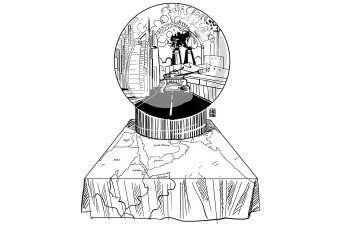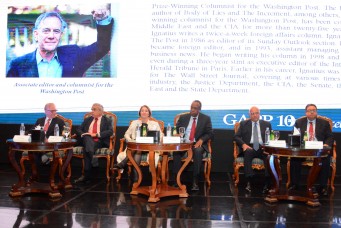Untold Futures
The American University in Cairo launched a massive research initiative that would ask Arab scholars and thinkers over the next three years to find answers to a crucial question: what does the future hold for the Middle East?

Inauguration ceremony of the “Al-Mostakbal: The Middle East Looking Forward.” Cairo. April 14. 2019.
In April of this year, the American University in Cairo launched a massive research initiative that would ask Arab scholars and thinkers over the next three years to find answers to a crucial question: what does the future hold for the Middle East? Underlying this question is an implicit aim to rectify the region’s past—largely dominated by outside powers throughout most of its recent history—while overcoming the challenges inherent to both an uncertain international system and a Middle East rife with turmoil. In the inauguration ceremony of the “Al-Mostakbal: The Middle East Looking Forward,” Arab panelists laid out their visions for the future.
Two important themes emerged throughout the talk. First, young people should become a top priority in the region moving forward. Arab states must employ a more robust and technologically forward education policy, and include youth in public life and political decision-making. Second, what makes up Arab identity is still open for debate in any future conceptualization of the Middle East.
Moving forward with the assertion that young people are critical to the future of the region, the next apparent question was how to empower them. Panelist Haifa Shaker Abu Ghazaleh, the assistant general-secretary and head of the social affairs sector at the League of Arab States, posed several questions about the way in which the education system as well as the needs of the job market are likely to change in the Arab World. “Will schools and colleges look the same way in the thirtieth century, and will the traditional teacher-centered model still be in use in light of new technological developments? How can we protect Arabic from extinction as hybrid forms of the language and its many dialects grow in popularity among young people on social media? Is the curriculum of today no longer compatible with future generations of Arabs?” Abu Ghazaleh concluded by urging for changes to the education system to better equip young people to meet the shifting needs of the job market.
Chairman of the Cairo-based Al Ismaelia For Real Estate Investments Karim Shafei added that by some estimates, nearly 75 percent of the jobs of tomorrow have not yet been created, pointing out the generational gap between Arabs under thirty and the rest of the region’s population, exacerbated by the rise of social media and instant access to information. Shafei went on to argue that despite the region’s youth bulge, young people clearly lack genuine political representation and roles in governance, posing a question that remains largely unanswered: what does the engagement of young people and women in the public sphere—which for many began with the protests of the Arab Spring—mean for the future of the region?
The issue of identity in the Arab World opened up questions of who should identify as Arab and whether the nation-state remains the best model of governance. Mohamed Benaissa, former minister of foreign affairs of Morocco, argued that “There is no one Arab world,” noting that he would divide the region into three distinct areas—Arab–African countries, Gulf states, and the Levant. The two most important problems facing the so-called “Arab World,” he added, lie in governance and societal stability within the context of cultural and religious pluralism. His advice? To engage the Arab people directly in state-building, drawing parallels to the 1972 book To Build with the People by Egyptian architect Hassan Fathy, famed for including poor communities in the process of developing sustainable building techniques in Upper Egypt.
Amre Moussa, former secretary general of the League of Arab States and former Egyptian minister of foreign affairs, took Benaissa’s point even further, suggesting that there was not a single Arab people, but a number of different ethnic and religious groups, such as Copts, Kurds, and Amazigh, that should be considered Arab. He argued for unity across state lines on this basis, in order to value true peacemaking over simply ensuring security. Peace, he argued, would encourage cultural exchange and economic cooperation, and would move the region forward as a whole—possibly creating a regional system that resembles the European Union.
Former Minister of Foreign Affairs of Palestine Nasser Alkidwa stressed that it is important to undo the fragility of Arab countries, which Alkidwa traced back to the arbitrary fashion in which borders were drawn across much of the Arab World following the collapse of the Ottoman Empire after the First World War. He argued that the construction of those borders carried the seeds of continuous conflict in the region such as in the cases of historical tensions between the Arab World and Israel as well as the threat of ongoing Israeli expansionism in the Golan Heights and the West Bank. Following this logic, he called for the defense of the nation-state as a fundamental building block of the region and championed security cooperation in the Arab World in light of Israeli and Iranian policies.
Perhaps the talk was never meant to lay out a cohesive path forward for the MENA region at this time, which will perhaps be a hefty task in the years to come. What it did do was reinforce the importance of education and call into question long held beliefs about identity and the roles of certain political groups in the region. This opportunity for Middle Easterners to do so without a colonial voice present was indeed a unique one, and perhaps the first step forward in carving out the region’s future.





